People, Culture and Contemporary Leadership: A Reflective Report
VerifiedAdded on 2021/05/31
|15
|2971
|40
Report
AI Summary
This report presents a reflective analysis of leadership skills and competencies in the context of people, culture, and contemporary leadership. The student conducted self-assessment through psychometric tests, including the Myers-Briggs and Big Five personality tests, to evaluate their leadership style and identify strengths and weaknesses. The report also incorporates insights gained from class activities, such as discussions and video analysis, to understand group dynamics and different leadership approaches. The student reflects on their leadership experiences, particularly during a workshop, and identifies areas for improvement, such as enhancing communication skills, building self-confidence, and managing emotional responses. The report concludes with a set of measures for future development, emphasizing the importance of continuous learning and the nurturing of leadership qualities for professional success.
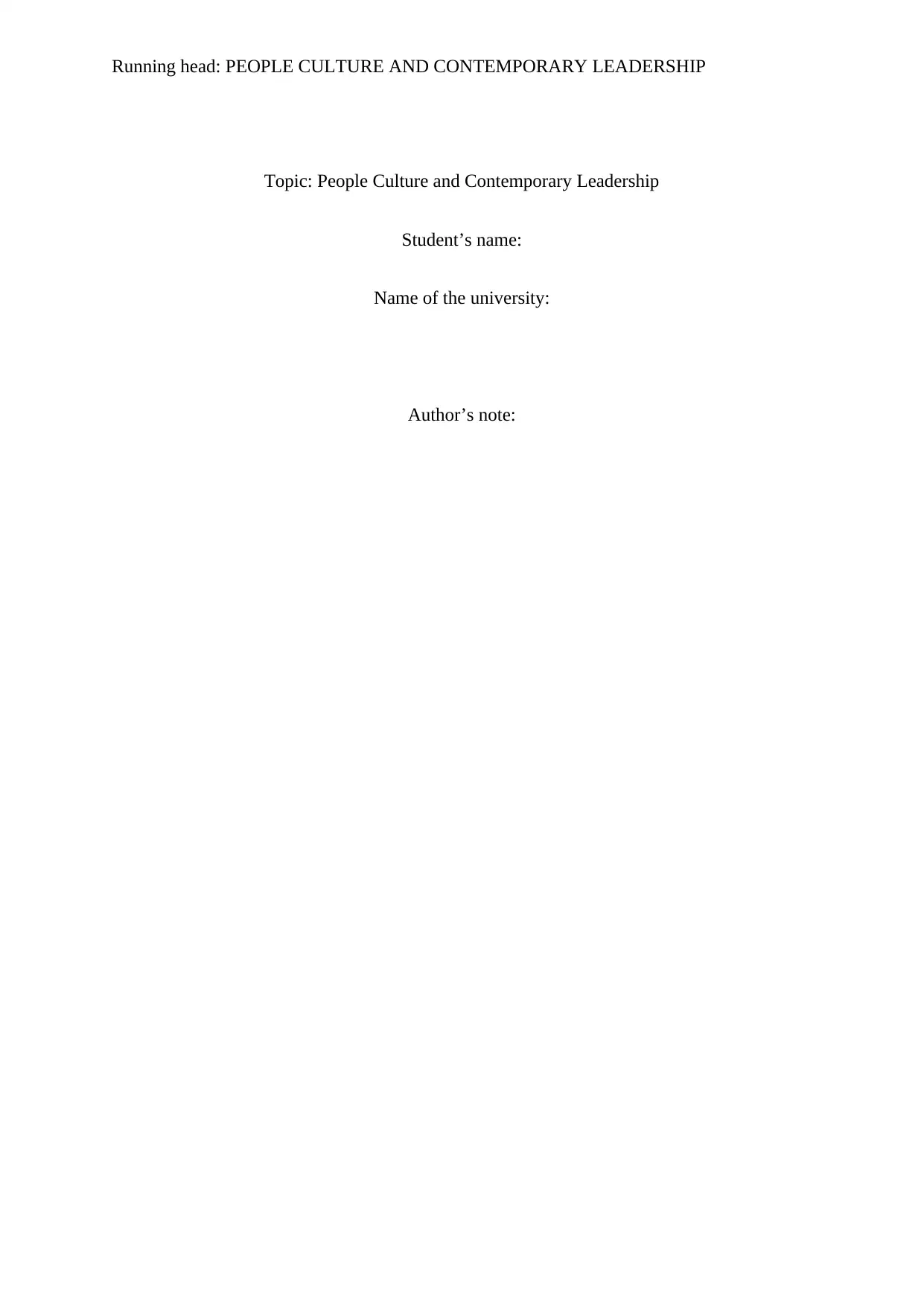
Running head: PEOPLE CULTURE AND CONTEMPORARY LEADERSHIP
Topic: People Culture and Contemporary Leadership
Student’s name:
Name of the university:
Author’s note:
Topic: People Culture and Contemporary Leadership
Student’s name:
Name of the university:
Author’s note:
Paraphrase This Document
Need a fresh take? Get an instant paraphrase of this document with our AI Paraphraser
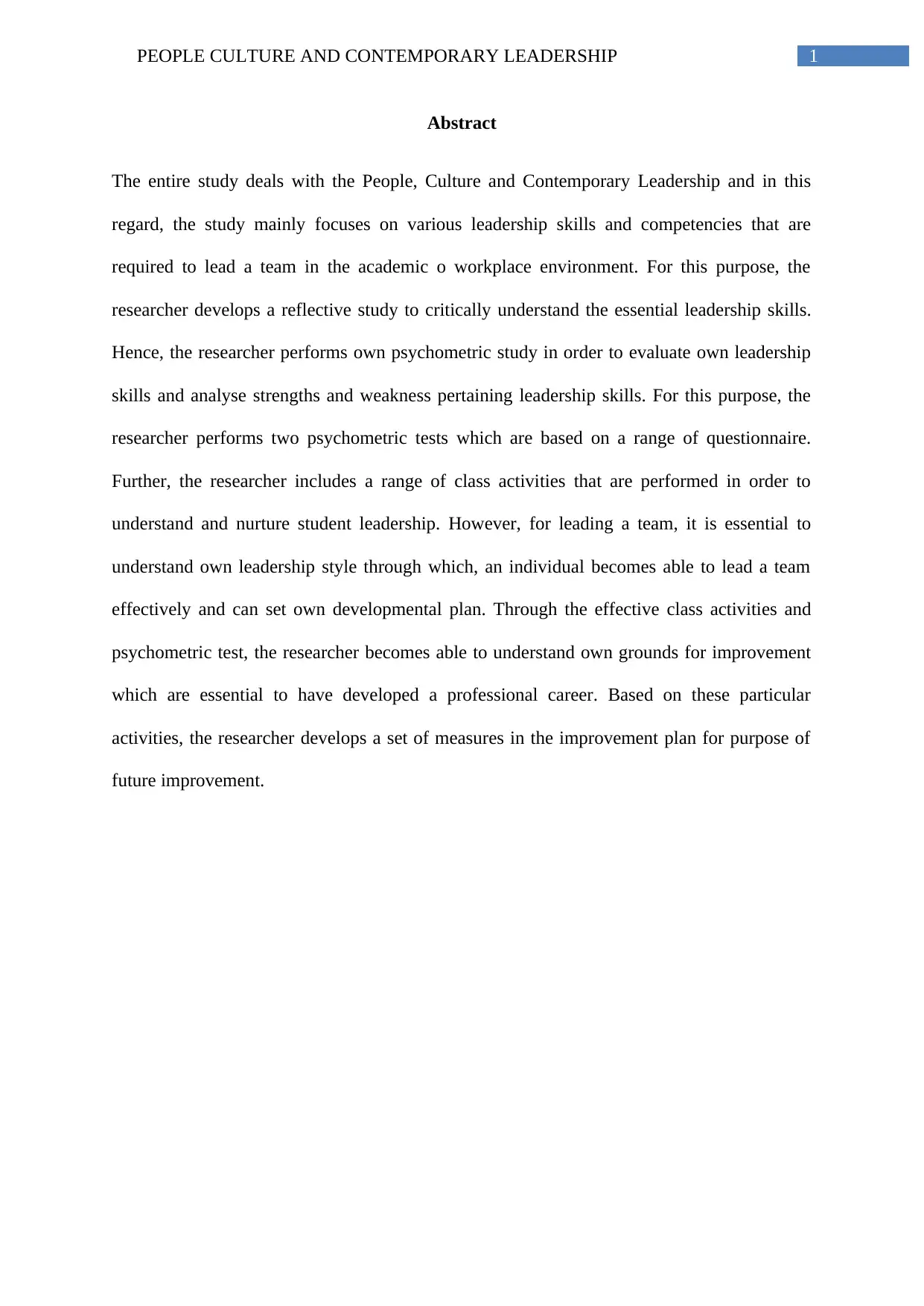
1PEOPLE CULTURE AND CONTEMPORARY LEADERSHIP
Abstract
The entire study deals with the People, Culture and Contemporary Leadership and in this
regard, the study mainly focuses on various leadership skills and competencies that are
required to lead a team in the academic o workplace environment. For this purpose, the
researcher develops a reflective study to critically understand the essential leadership skills.
Hence, the researcher performs own psychometric study in order to evaluate own leadership
skills and analyse strengths and weakness pertaining leadership skills. For this purpose, the
researcher performs two psychometric tests which are based on a range of questionnaire.
Further, the researcher includes a range of class activities that are performed in order to
understand and nurture student leadership. However, for leading a team, it is essential to
understand own leadership style through which, an individual becomes able to lead a team
effectively and can set own developmental plan. Through the effective class activities and
psychometric test, the researcher becomes able to understand own grounds for improvement
which are essential to have developed a professional career. Based on these particular
activities, the researcher develops a set of measures in the improvement plan for purpose of
future improvement.
Abstract
The entire study deals with the People, Culture and Contemporary Leadership and in this
regard, the study mainly focuses on various leadership skills and competencies that are
required to lead a team in the academic o workplace environment. For this purpose, the
researcher develops a reflective study to critically understand the essential leadership skills.
Hence, the researcher performs own psychometric study in order to evaluate own leadership
skills and analyse strengths and weakness pertaining leadership skills. For this purpose, the
researcher performs two psychometric tests which are based on a range of questionnaire.
Further, the researcher includes a range of class activities that are performed in order to
understand and nurture student leadership. However, for leading a team, it is essential to
understand own leadership style through which, an individual becomes able to lead a team
effectively and can set own developmental plan. Through the effective class activities and
psychometric test, the researcher becomes able to understand own grounds for improvement
which are essential to have developed a professional career. Based on these particular
activities, the researcher develops a set of measures in the improvement plan for purpose of
future improvement.

2PEOPLE CULTURE AND CONTEMPORARY LEADERSHIP
One of the most significant employability skills includes leadership qualities that are
essential for an individual to escalate professional career effectively. Establishing significant
leadership quality in the professional context is not an easy task to nurture (Anderson and
Sun 2017). In this regard, the study seeks to develop a reflective study regarding leadership
skills and for this purpose, I will take a critical look at my own leadership skills. Hence, the
study includes an analysis of own experience for critically reflect on own feelings, thoughts
and actions. During the time of the workshop, I had to lead a team that was assigned to design
an advertising campaign for a beverage product of the organisation. There were around seven
members in the team and each member is unknown to each other. Initially, I found it very
difficult to perform my own roles and responsibilities due to lack of competences of
leadership. In this study, I am going to analyse my own leadership competencies and
qualities. Further, based on the class activities and another set of questionnaires, I am going
to find out essential skills for improvement that are required to establish the individual as a
successful leader in the future career.
Leadership is all about the action of leading an organisation or a group of people to do
right things. For this purpose, they set direction, create something that is new and they build
an inspiring vision for team members as well so that, they can guide people to the right
direction in some of the smooth and efficient ways. According to (Arnold et al. 2015),
leadership all about mapping out where a group of people need to go to get success as a team
and leadership is exciting, dynamic and inspiring. On some other words, it can be stated that
leadership is the particular potential of an individual that impacts on the behaviour of others.
From my point of view, leaders need to accomplish some interpersonal skills such as
maturity, personality and intelligence so that, an individual becomes able to develop set of
vision to lead and motivate team members for reaching organisational goals and objectives.
One of the most significant employability skills includes leadership qualities that are
essential for an individual to escalate professional career effectively. Establishing significant
leadership quality in the professional context is not an easy task to nurture (Anderson and
Sun 2017). In this regard, the study seeks to develop a reflective study regarding leadership
skills and for this purpose, I will take a critical look at my own leadership skills. Hence, the
study includes an analysis of own experience for critically reflect on own feelings, thoughts
and actions. During the time of the workshop, I had to lead a team that was assigned to design
an advertising campaign for a beverage product of the organisation. There were around seven
members in the team and each member is unknown to each other. Initially, I found it very
difficult to perform my own roles and responsibilities due to lack of competences of
leadership. In this study, I am going to analyse my own leadership competencies and
qualities. Further, based on the class activities and another set of questionnaires, I am going
to find out essential skills for improvement that are required to establish the individual as a
successful leader in the future career.
Leadership is all about the action of leading an organisation or a group of people to do
right things. For this purpose, they set direction, create something that is new and they build
an inspiring vision for team members as well so that, they can guide people to the right
direction in some of the smooth and efficient ways. According to (Arnold et al. 2015),
leadership all about mapping out where a group of people need to go to get success as a team
and leadership is exciting, dynamic and inspiring. On some other words, it can be stated that
leadership is the particular potential of an individual that impacts on the behaviour of others.
From my point of view, leaders need to accomplish some interpersonal skills such as
maturity, personality and intelligence so that, an individual becomes able to develop set of
vision to lead and motivate team members for reaching organisational goals and objectives.
⊘ This is a preview!⊘
Do you want full access?
Subscribe today to unlock all pages.

Trusted by 1+ million students worldwide

3PEOPLE CULTURE AND CONTEMPORARY LEADERSHIP
In this scenario, Path-Goal theory can be used for gaining an understanding of
leadership styles or behaviour that best fits the employee and the work environment for
achieving the goal. The goal or objective is to enhance employees' empowerment, motivation
and level of satisfaction so that; an individual can place oneself as a productive member of
the organisational entity. It is worth mentioning that, Path-goal basically follows Vroom’s
Expectancy Theory of the year 1964. According to the theory, individual usually acts in a
certain way followed by the given outcome and the attractiveness of the outcome. It is worth
mentioning that, this particular theory entirely deals with leadership behaviour that leaders
adapt as per the demand of the situation. Further, as per the concerned theory, it can be stated
that leaders are responsible to guide employees through the path for the purpose of obtaining
their daily work activities (which are actually goals). As opined by Hirt (2016), Path-Goal
theory is all about a detailed process but follows three basic steps that include employee and
workplace environmental characteristics (experience, locus of control and ability), leadership
style (directive, achievement-oriented, supportive and participative) and the other one is
motivational factors (define goal, provide support, clarify path and remove obstacles) that
lead to employee success. During my workshop, while playing the role of leader, I maintain
the workgroup significantly and my team members were supportive in nature and they had
shown enthusiastic and collaborative culture while working together.
A set of questionnaire helped me to identify my own characteristics as a leader.
Hence, I perform Myers-Brigg personality test that provides an overview regarding
individual’s psychological types. There are mainly 16 different personality types in Myers-
Brigg test and people are characterised based on the indicators (Judge and Zapata 2015). The
eight main dimensions of this psychological test include extraversion (E), thinking (T),
intuition (I), sensing (S), introversion (I), feeling (F), perceiving (P) and the final one is
judging (J). Based on the personality test, I have found out my personality characteristics and
In this scenario, Path-Goal theory can be used for gaining an understanding of
leadership styles or behaviour that best fits the employee and the work environment for
achieving the goal. The goal or objective is to enhance employees' empowerment, motivation
and level of satisfaction so that; an individual can place oneself as a productive member of
the organisational entity. It is worth mentioning that, Path-goal basically follows Vroom’s
Expectancy Theory of the year 1964. According to the theory, individual usually acts in a
certain way followed by the given outcome and the attractiveness of the outcome. It is worth
mentioning that, this particular theory entirely deals with leadership behaviour that leaders
adapt as per the demand of the situation. Further, as per the concerned theory, it can be stated
that leaders are responsible to guide employees through the path for the purpose of obtaining
their daily work activities (which are actually goals). As opined by Hirt (2016), Path-Goal
theory is all about a detailed process but follows three basic steps that include employee and
workplace environmental characteristics (experience, locus of control and ability), leadership
style (directive, achievement-oriented, supportive and participative) and the other one is
motivational factors (define goal, provide support, clarify path and remove obstacles) that
lead to employee success. During my workshop, while playing the role of leader, I maintain
the workgroup significantly and my team members were supportive in nature and they had
shown enthusiastic and collaborative culture while working together.
A set of questionnaire helped me to identify my own characteristics as a leader.
Hence, I perform Myers-Brigg personality test that provides an overview regarding
individual’s psychological types. There are mainly 16 different personality types in Myers-
Brigg test and people are characterised based on the indicators (Judge and Zapata 2015). The
eight main dimensions of this psychological test include extraversion (E), thinking (T),
intuition (I), sensing (S), introversion (I), feeling (F), perceiving (P) and the final one is
judging (J). Based on the personality test, I have found out my personality characteristics and
Paraphrase This Document
Need a fresh take? Get an instant paraphrase of this document with our AI Paraphraser
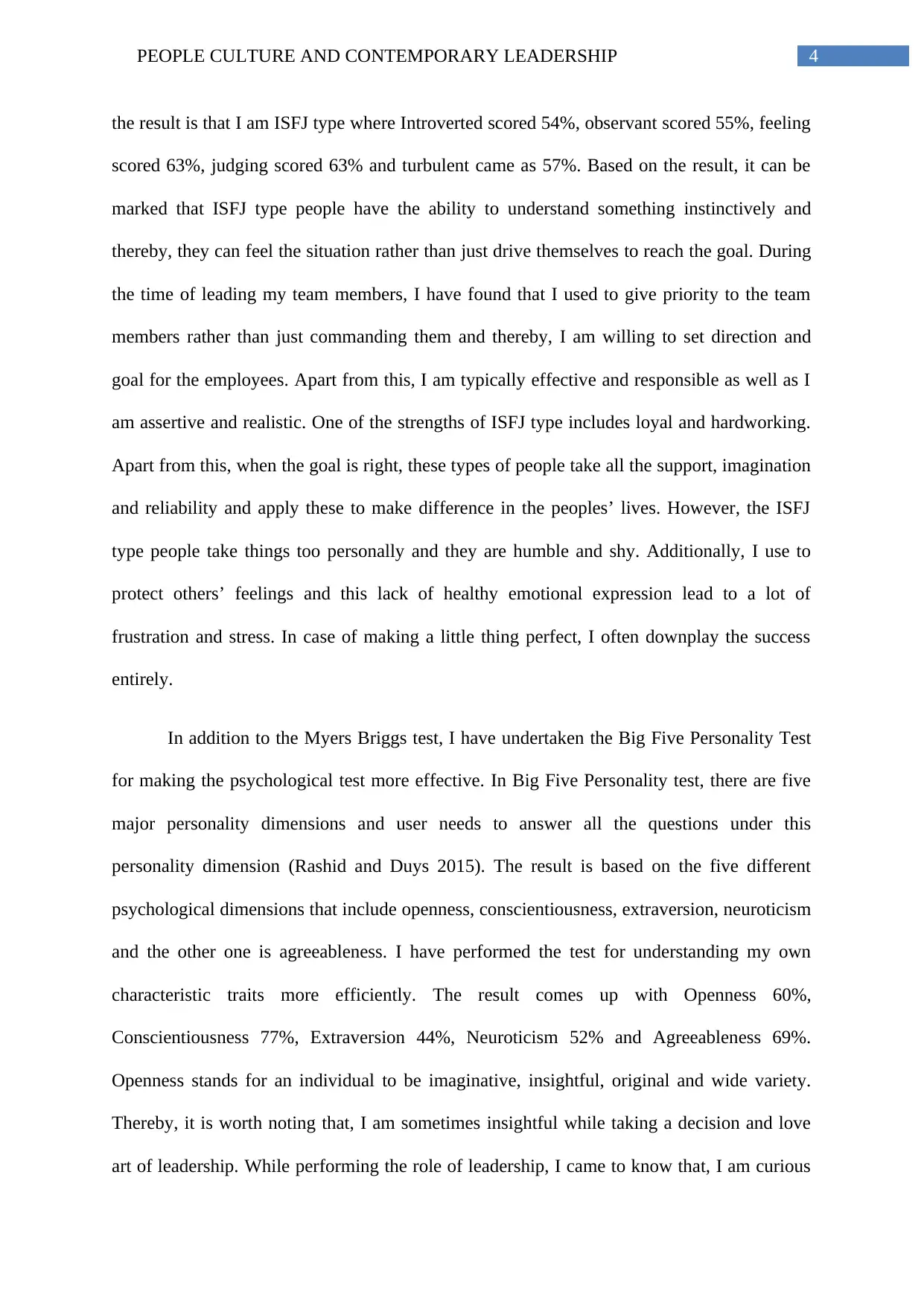
4PEOPLE CULTURE AND CONTEMPORARY LEADERSHIP
the result is that I am ISFJ type where Introverted scored 54%, observant scored 55%, feeling
scored 63%, judging scored 63% and turbulent came as 57%. Based on the result, it can be
marked that ISFJ type people have the ability to understand something instinctively and
thereby, they can feel the situation rather than just drive themselves to reach the goal. During
the time of leading my team members, I have found that I used to give priority to the team
members rather than just commanding them and thereby, I am willing to set direction and
goal for the employees. Apart from this, I am typically effective and responsible as well as I
am assertive and realistic. One of the strengths of ISFJ type includes loyal and hardworking.
Apart from this, when the goal is right, these types of people take all the support, imagination
and reliability and apply these to make difference in the peoples’ lives. However, the ISFJ
type people take things too personally and they are humble and shy. Additionally, I use to
protect others’ feelings and this lack of healthy emotional expression lead to a lot of
frustration and stress. In case of making a little thing perfect, I often downplay the success
entirely.
In addition to the Myers Briggs test, I have undertaken the Big Five Personality Test
for making the psychological test more effective. In Big Five Personality test, there are five
major personality dimensions and user needs to answer all the questions under this
personality dimension (Rashid and Duys 2015). The result is based on the five different
psychological dimensions that include openness, conscientiousness, extraversion, neuroticism
and the other one is agreeableness. I have performed the test for understanding my own
characteristic traits more efficiently. The result comes up with Openness 60%,
Conscientiousness 77%, Extraversion 44%, Neuroticism 52% and Agreeableness 69%.
Openness stands for an individual to be imaginative, insightful, original and wide variety.
Thereby, it is worth noting that, I am sometimes insightful while taking a decision and love
art of leadership. While performing the role of leadership, I came to know that, I am curious
the result is that I am ISFJ type where Introverted scored 54%, observant scored 55%, feeling
scored 63%, judging scored 63% and turbulent came as 57%. Based on the result, it can be
marked that ISFJ type people have the ability to understand something instinctively and
thereby, they can feel the situation rather than just drive themselves to reach the goal. During
the time of leading my team members, I have found that I used to give priority to the team
members rather than just commanding them and thereby, I am willing to set direction and
goal for the employees. Apart from this, I am typically effective and responsible as well as I
am assertive and realistic. One of the strengths of ISFJ type includes loyal and hardworking.
Apart from this, when the goal is right, these types of people take all the support, imagination
and reliability and apply these to make difference in the peoples’ lives. However, the ISFJ
type people take things too personally and they are humble and shy. Additionally, I use to
protect others’ feelings and this lack of healthy emotional expression lead to a lot of
frustration and stress. In case of making a little thing perfect, I often downplay the success
entirely.
In addition to the Myers Briggs test, I have undertaken the Big Five Personality Test
for making the psychological test more effective. In Big Five Personality test, there are five
major personality dimensions and user needs to answer all the questions under this
personality dimension (Rashid and Duys 2015). The result is based on the five different
psychological dimensions that include openness, conscientiousness, extraversion, neuroticism
and the other one is agreeableness. I have performed the test for understanding my own
characteristic traits more efficiently. The result comes up with Openness 60%,
Conscientiousness 77%, Extraversion 44%, Neuroticism 52% and Agreeableness 69%.
Openness stands for an individual to be imaginative, insightful, original and wide variety.
Thereby, it is worth noting that, I am sometimes insightful while taking a decision and love
art of leadership. While performing the role of leadership, I came to know that, I am curious
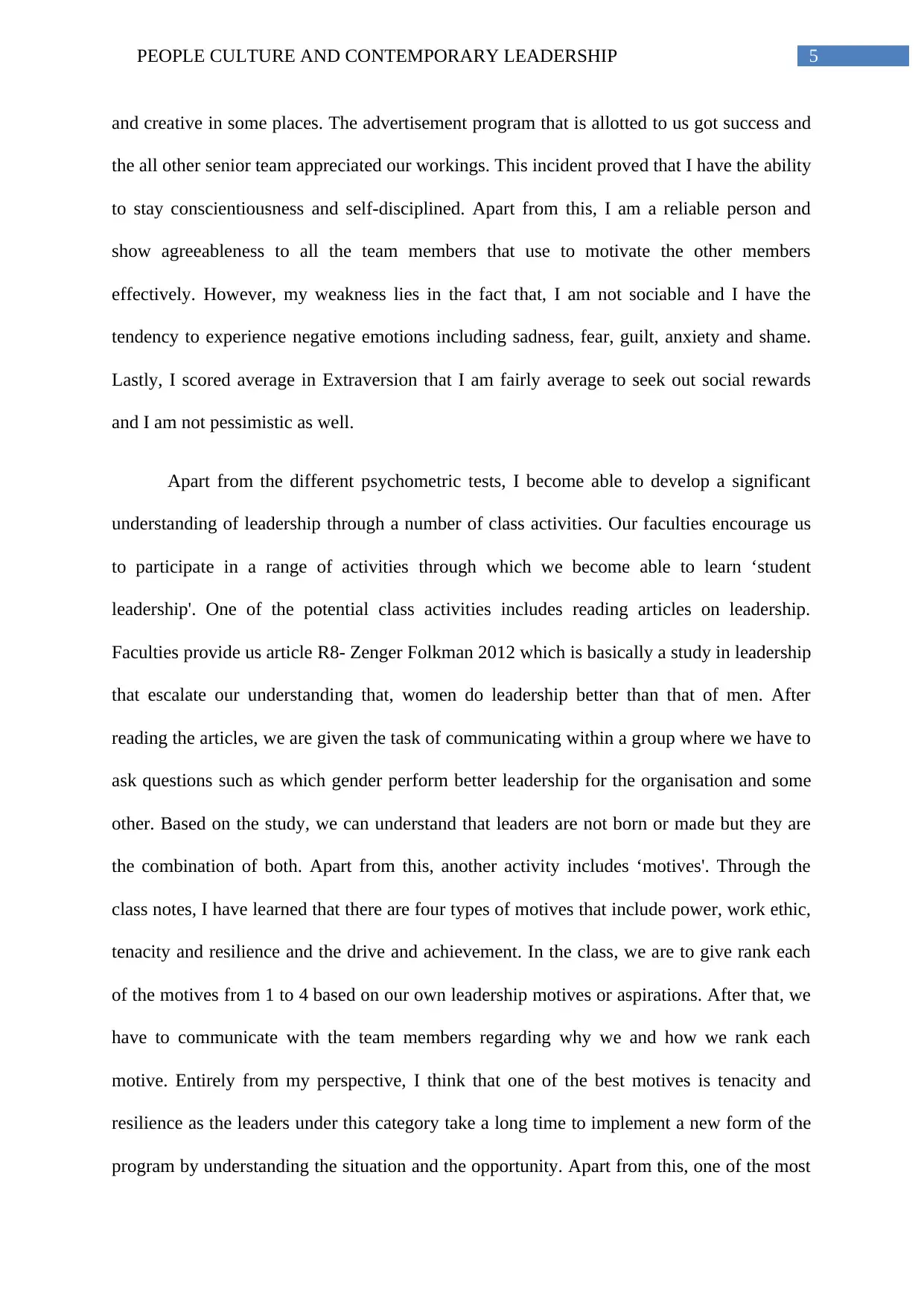
5PEOPLE CULTURE AND CONTEMPORARY LEADERSHIP
and creative in some places. The advertisement program that is allotted to us got success and
the all other senior team appreciated our workings. This incident proved that I have the ability
to stay conscientiousness and self-disciplined. Apart from this, I am a reliable person and
show agreeableness to all the team members that use to motivate the other members
effectively. However, my weakness lies in the fact that, I am not sociable and I have the
tendency to experience negative emotions including sadness, fear, guilt, anxiety and shame.
Lastly, I scored average in Extraversion that I am fairly average to seek out social rewards
and I am not pessimistic as well.
Apart from the different psychometric tests, I become able to develop a significant
understanding of leadership through a number of class activities. Our faculties encourage us
to participate in a range of activities through which we become able to learn ‘student
leadership'. One of the potential class activities includes reading articles on leadership.
Faculties provide us article R8- Zenger Folkman 2012 which is basically a study in leadership
that escalate our understanding that, women do leadership better than that of men. After
reading the articles, we are given the task of communicating within a group where we have to
ask questions such as which gender perform better leadership for the organisation and some
other. Based on the study, we can understand that leaders are not born or made but they are
the combination of both. Apart from this, another activity includes ‘motives'. Through the
class notes, I have learned that there are four types of motives that include power, work ethic,
tenacity and resilience and the drive and achievement. In the class, we are to give rank each
of the motives from 1 to 4 based on our own leadership motives or aspirations. After that, we
have to communicate with the team members regarding why we and how we rank each
motive. Entirely from my perspective, I think that one of the best motives is tenacity and
resilience as the leaders under this category take a long time to implement a new form of the
program by understanding the situation and the opportunity. Apart from this, one of the most
and creative in some places. The advertisement program that is allotted to us got success and
the all other senior team appreciated our workings. This incident proved that I have the ability
to stay conscientiousness and self-disciplined. Apart from this, I am a reliable person and
show agreeableness to all the team members that use to motivate the other members
effectively. However, my weakness lies in the fact that, I am not sociable and I have the
tendency to experience negative emotions including sadness, fear, guilt, anxiety and shame.
Lastly, I scored average in Extraversion that I am fairly average to seek out social rewards
and I am not pessimistic as well.
Apart from the different psychometric tests, I become able to develop a significant
understanding of leadership through a number of class activities. Our faculties encourage us
to participate in a range of activities through which we become able to learn ‘student
leadership'. One of the potential class activities includes reading articles on leadership.
Faculties provide us article R8- Zenger Folkman 2012 which is basically a study in leadership
that escalate our understanding that, women do leadership better than that of men. After
reading the articles, we are given the task of communicating within a group where we have to
ask questions such as which gender perform better leadership for the organisation and some
other. Based on the study, we can understand that leaders are not born or made but they are
the combination of both. Apart from this, another activity includes ‘motives'. Through the
class notes, I have learned that there are four types of motives that include power, work ethic,
tenacity and resilience and the drive and achievement. In the class, we are to give rank each
of the motives from 1 to 4 based on our own leadership motives or aspirations. After that, we
have to communicate with the team members regarding why we and how we rank each
motive. Entirely from my perspective, I think that one of the best motives is tenacity and
resilience as the leaders under this category take a long time to implement a new form of the
program by understanding the situation and the opportunity. Apart from this, one of the most
⊘ This is a preview!⊘
Do you want full access?
Subscribe today to unlock all pages.

Trusted by 1+ million students worldwide
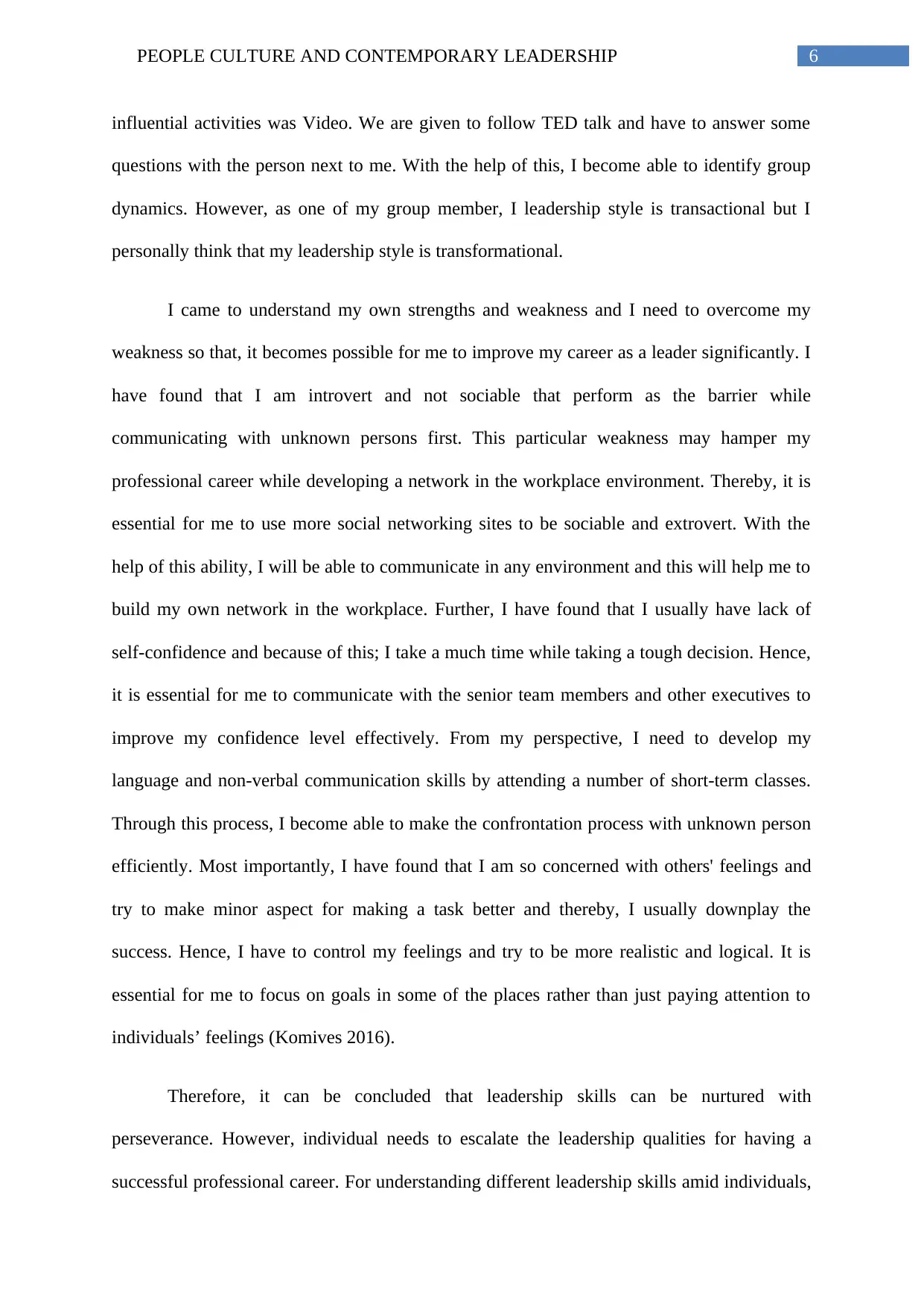
6PEOPLE CULTURE AND CONTEMPORARY LEADERSHIP
influential activities was Video. We are given to follow TED talk and have to answer some
questions with the person next to me. With the help of this, I become able to identify group
dynamics. However, as one of my group member, I leadership style is transactional but I
personally think that my leadership style is transformational.
I came to understand my own strengths and weakness and I need to overcome my
weakness so that, it becomes possible for me to improve my career as a leader significantly. I
have found that I am introvert and not sociable that perform as the barrier while
communicating with unknown persons first. This particular weakness may hamper my
professional career while developing a network in the workplace environment. Thereby, it is
essential for me to use more social networking sites to be sociable and extrovert. With the
help of this ability, I will be able to communicate in any environment and this will help me to
build my own network in the workplace. Further, I have found that I usually have lack of
self-confidence and because of this; I take a much time while taking a tough decision. Hence,
it is essential for me to communicate with the senior team members and other executives to
improve my confidence level effectively. From my perspective, I need to develop my
language and non-verbal communication skills by attending a number of short-term classes.
Through this process, I become able to make the confrontation process with unknown person
efficiently. Most importantly, I have found that I am so concerned with others' feelings and
try to make minor aspect for making a task better and thereby, I usually downplay the
success. Hence, I have to control my feelings and try to be more realistic and logical. It is
essential for me to focus on goals in some of the places rather than just paying attention to
individuals’ feelings (Komives 2016).
Therefore, it can be concluded that leadership skills can be nurtured with
perseverance. However, individual needs to escalate the leadership qualities for having a
successful professional career. For understanding different leadership skills amid individuals,
influential activities was Video. We are given to follow TED talk and have to answer some
questions with the person next to me. With the help of this, I become able to identify group
dynamics. However, as one of my group member, I leadership style is transactional but I
personally think that my leadership style is transformational.
I came to understand my own strengths and weakness and I need to overcome my
weakness so that, it becomes possible for me to improve my career as a leader significantly. I
have found that I am introvert and not sociable that perform as the barrier while
communicating with unknown persons first. This particular weakness may hamper my
professional career while developing a network in the workplace environment. Thereby, it is
essential for me to use more social networking sites to be sociable and extrovert. With the
help of this ability, I will be able to communicate in any environment and this will help me to
build my own network in the workplace. Further, I have found that I usually have lack of
self-confidence and because of this; I take a much time while taking a tough decision. Hence,
it is essential for me to communicate with the senior team members and other executives to
improve my confidence level effectively. From my perspective, I need to develop my
language and non-verbal communication skills by attending a number of short-term classes.
Through this process, I become able to make the confrontation process with unknown person
efficiently. Most importantly, I have found that I am so concerned with others' feelings and
try to make minor aspect for making a task better and thereby, I usually downplay the
success. Hence, I have to control my feelings and try to be more realistic and logical. It is
essential for me to focus on goals in some of the places rather than just paying attention to
individuals’ feelings (Komives 2016).
Therefore, it can be concluded that leadership skills can be nurtured with
perseverance. However, individual needs to escalate the leadership qualities for having a
successful professional career. For understanding different leadership skills amid individuals,
Paraphrase This Document
Need a fresh take? Get an instant paraphrase of this document with our AI Paraphraser
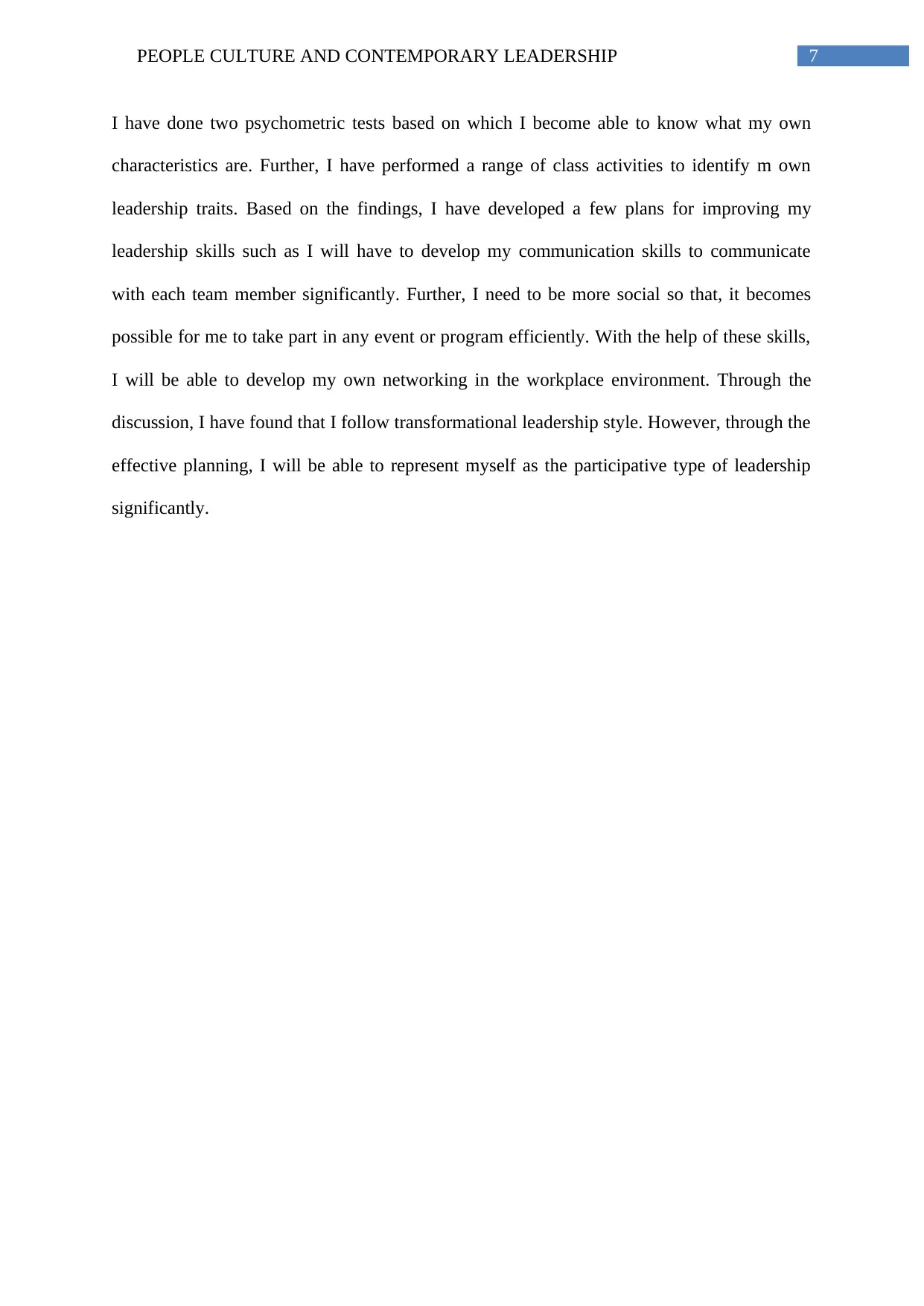
7PEOPLE CULTURE AND CONTEMPORARY LEADERSHIP
I have done two psychometric tests based on which I become able to know what my own
characteristics are. Further, I have performed a range of class activities to identify m own
leadership traits. Based on the findings, I have developed a few plans for improving my
leadership skills such as I will have to develop my communication skills to communicate
with each team member significantly. Further, I need to be more social so that, it becomes
possible for me to take part in any event or program efficiently. With the help of these skills,
I will be able to develop my own networking in the workplace environment. Through the
discussion, I have found that I follow transformational leadership style. However, through the
effective planning, I will be able to represent myself as the participative type of leadership
significantly.
I have done two psychometric tests based on which I become able to know what my own
characteristics are. Further, I have performed a range of class activities to identify m own
leadership traits. Based on the findings, I have developed a few plans for improving my
leadership skills such as I will have to develop my communication skills to communicate
with each team member significantly. Further, I need to be more social so that, it becomes
possible for me to take part in any event or program efficiently. With the help of these skills,
I will be able to develop my own networking in the workplace environment. Through the
discussion, I have found that I follow transformational leadership style. However, through the
effective planning, I will be able to represent myself as the participative type of leadership
significantly.

8PEOPLE CULTURE AND CONTEMPORARY LEADERSHIP
Reference list
Anderson, M.H. and Sun, P.Y., 2017. Reviewing leadership styles: Overlaps and the need for
a new ‘full‐range’theory. International Journal of Management Reviews, 19(1), pp.76-96.
Arnold, K.A., Connelly, C.E., Walsh, M.M. and Martin Ginis, K.A., 2015. Leadership styles,
emotion regulation, and burnout. Journal of Occupational Health Psychology, 20(4), p.481.
Day, D.V., Fleenor, J.W., Atwater, L.E., Sturm, R.E. and McKee, R.A., 2014. Advances in
leader and leadership development: A review of 25 years of research and theory. The
Leadership Quarterly, 25(1), pp.63-82.
Goetsch, D.L. and Davis, S.B., 2014. Quality management for organizational excellence.
Upper Saddle River, NJ: Pearson.
Hirt, M.J.K., 2016. Path-Goal Theory of Leadership: Leadership and Public
Management. Global Encyclopedia of Public Administration, Public Policy, and
Governance, pp.1-6.
Judge, T.A. and Zapata, C.P., 2015. The person-situation debate revisited: Effect of situation
strength and trait activation on the validity of the Big Five personality traits in predicting job
performance. Academy of Management Journal, 58(4), pp.1149-1179.
Komives, S.R., 2016. Leadership for a better world: Understanding the social change model
of leadership development. New Jersey: John Wiley & Sons.
Potter, C., 2015. Leadership development: an applied comparison of Gibbs’ Reflective Cycle
and Scharmer’s Theory U. Industrial and Commercial Training, 47(6), pp.336-342.
Reference list
Anderson, M.H. and Sun, P.Y., 2017. Reviewing leadership styles: Overlaps and the need for
a new ‘full‐range’theory. International Journal of Management Reviews, 19(1), pp.76-96.
Arnold, K.A., Connelly, C.E., Walsh, M.M. and Martin Ginis, K.A., 2015. Leadership styles,
emotion regulation, and burnout. Journal of Occupational Health Psychology, 20(4), p.481.
Day, D.V., Fleenor, J.W., Atwater, L.E., Sturm, R.E. and McKee, R.A., 2014. Advances in
leader and leadership development: A review of 25 years of research and theory. The
Leadership Quarterly, 25(1), pp.63-82.
Goetsch, D.L. and Davis, S.B., 2014. Quality management for organizational excellence.
Upper Saddle River, NJ: Pearson.
Hirt, M.J.K., 2016. Path-Goal Theory of Leadership: Leadership and Public
Management. Global Encyclopedia of Public Administration, Public Policy, and
Governance, pp.1-6.
Judge, T.A. and Zapata, C.P., 2015. The person-situation debate revisited: Effect of situation
strength and trait activation on the validity of the Big Five personality traits in predicting job
performance. Academy of Management Journal, 58(4), pp.1149-1179.
Komives, S.R., 2016. Leadership for a better world: Understanding the social change model
of leadership development. New Jersey: John Wiley & Sons.
Potter, C., 2015. Leadership development: an applied comparison of Gibbs’ Reflective Cycle
and Scharmer’s Theory U. Industrial and Commercial Training, 47(6), pp.336-342.
⊘ This is a preview!⊘
Do you want full access?
Subscribe today to unlock all pages.

Trusted by 1+ million students worldwide
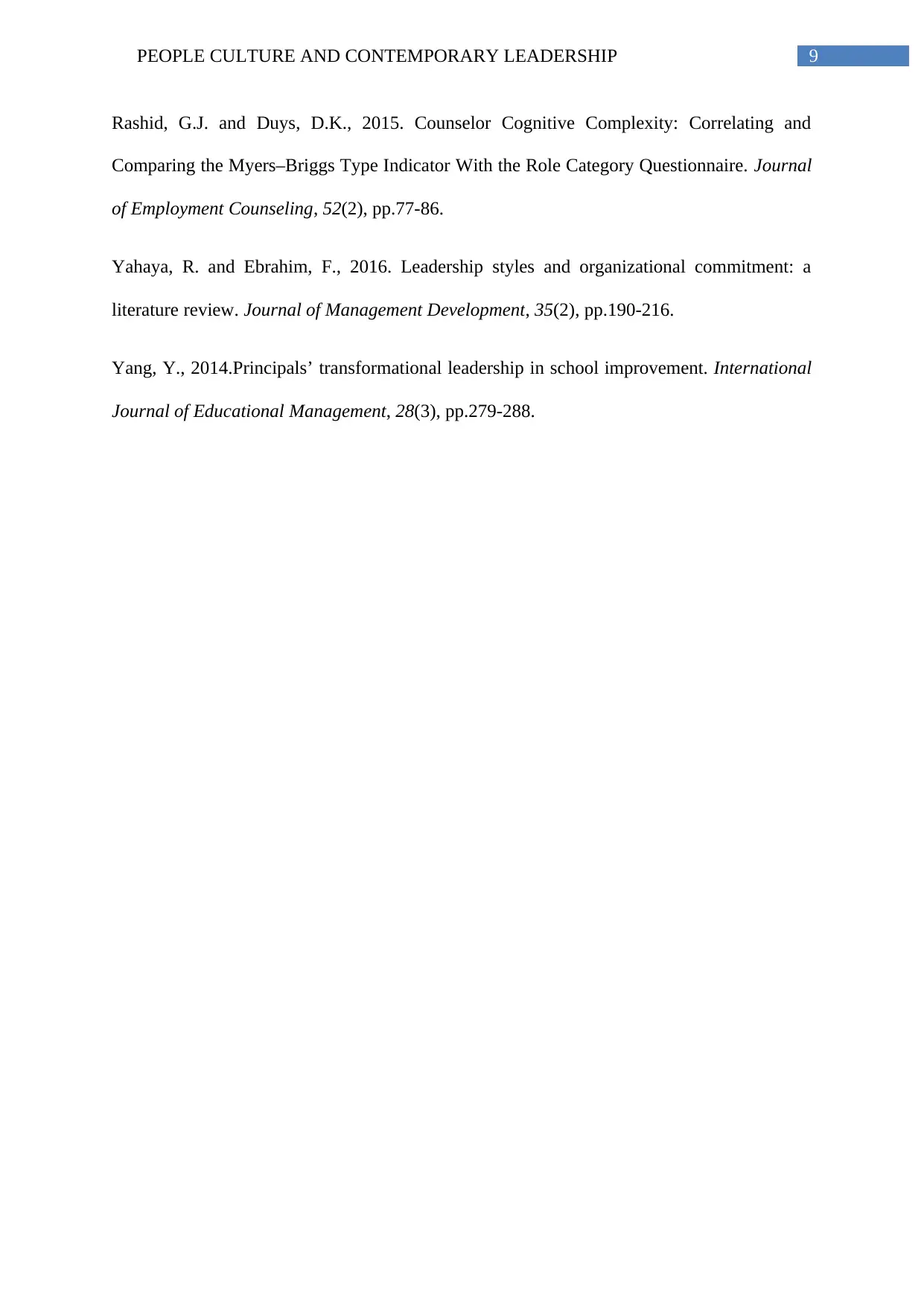
9PEOPLE CULTURE AND CONTEMPORARY LEADERSHIP
Rashid, G.J. and Duys, D.K., 2015. Counselor Cognitive Complexity: Correlating and
Comparing the Myers–Briggs Type Indicator With the Role Category Questionnaire. Journal
of Employment Counseling, 52(2), pp.77-86.
Yahaya, R. and Ebrahim, F., 2016. Leadership styles and organizational commitment: a
literature review. Journal of Management Development, 35(2), pp.190-216.
Yang, Y., 2014.Principals’ transformational leadership in school improvement. International
Journal of Educational Management, 28(3), pp.279-288.
Rashid, G.J. and Duys, D.K., 2015. Counselor Cognitive Complexity: Correlating and
Comparing the Myers–Briggs Type Indicator With the Role Category Questionnaire. Journal
of Employment Counseling, 52(2), pp.77-86.
Yahaya, R. and Ebrahim, F., 2016. Leadership styles and organizational commitment: a
literature review. Journal of Management Development, 35(2), pp.190-216.
Yang, Y., 2014.Principals’ transformational leadership in school improvement. International
Journal of Educational Management, 28(3), pp.279-288.
Paraphrase This Document
Need a fresh take? Get an instant paraphrase of this document with our AI Paraphraser
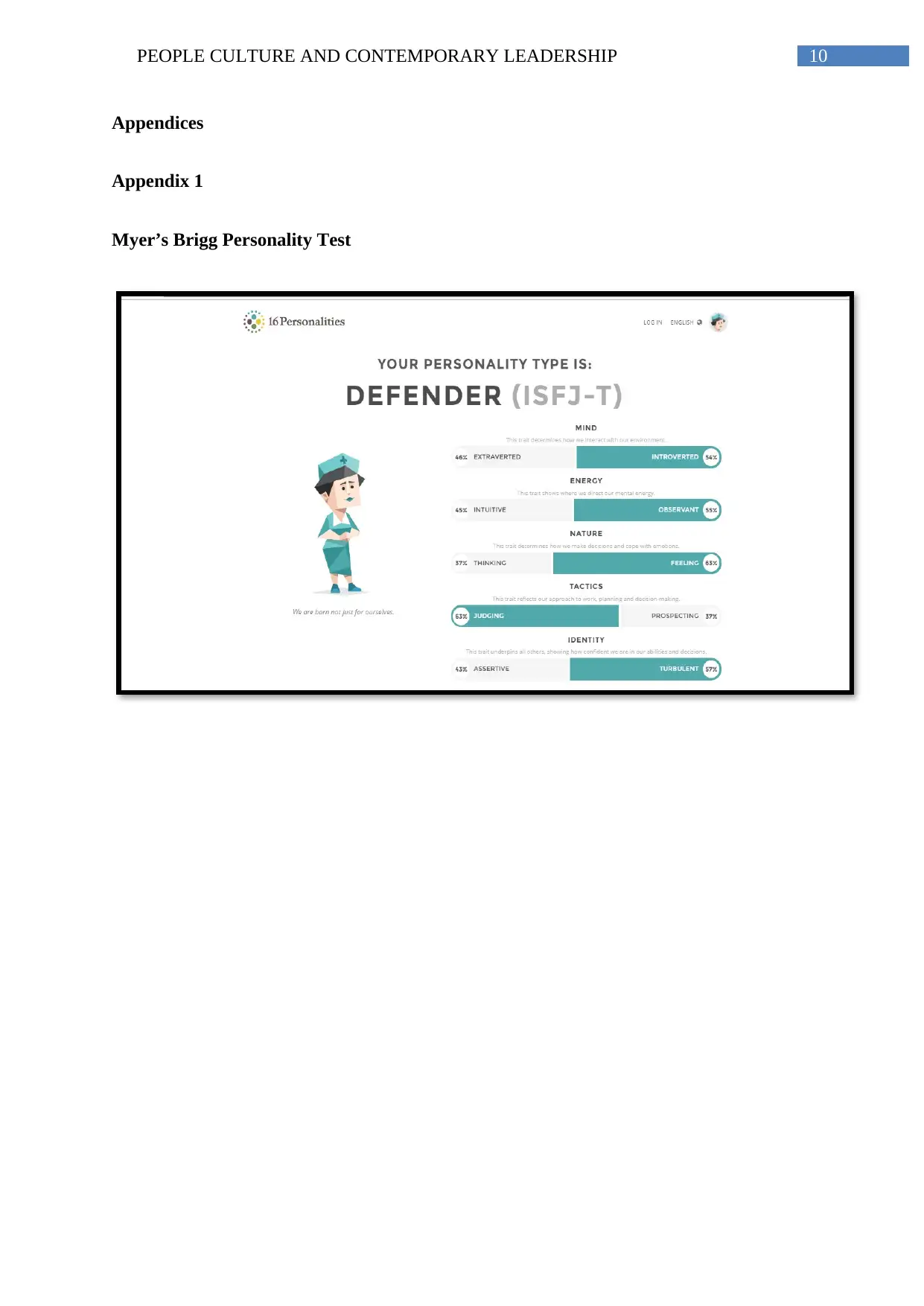
10PEOPLE CULTURE AND CONTEMPORARY LEADERSHIP
Appendices
Appendix 1
Myer’s Brigg Personality Test
Appendices
Appendix 1
Myer’s Brigg Personality Test
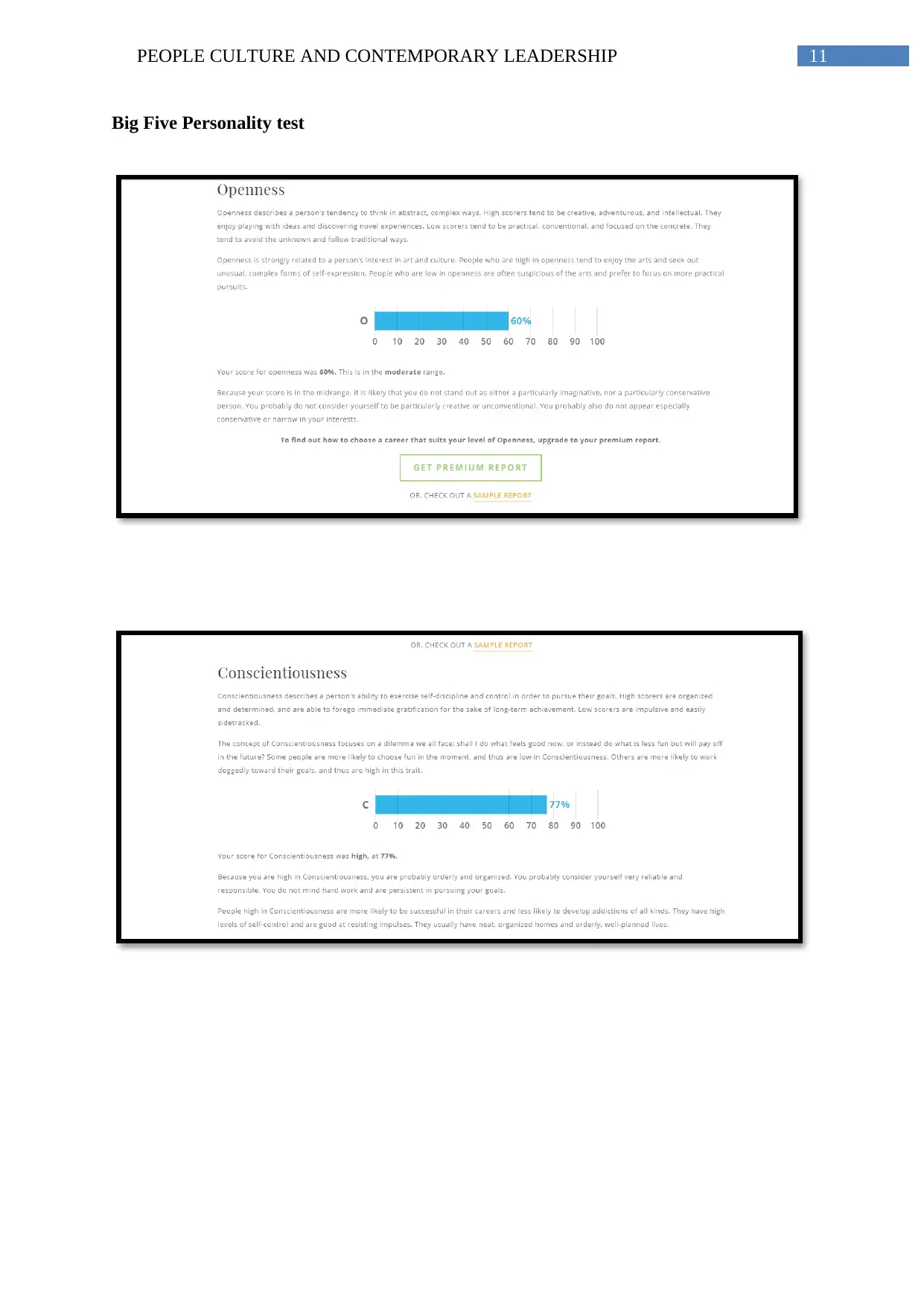
11PEOPLE CULTURE AND CONTEMPORARY LEADERSHIP
Big Five Personality test
Big Five Personality test
⊘ This is a preview!⊘
Do you want full access?
Subscribe today to unlock all pages.

Trusted by 1+ million students worldwide
1 out of 15
Related Documents
Your All-in-One AI-Powered Toolkit for Academic Success.
+13062052269
info@desklib.com
Available 24*7 on WhatsApp / Email
![[object Object]](/_next/static/media/star-bottom.7253800d.svg)
Unlock your academic potential
Copyright © 2020–2025 A2Z Services. All Rights Reserved. Developed and managed by ZUCOL.




